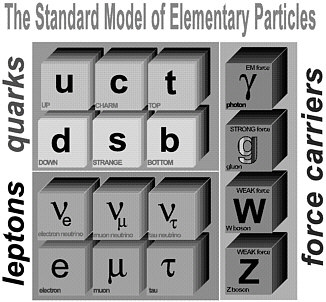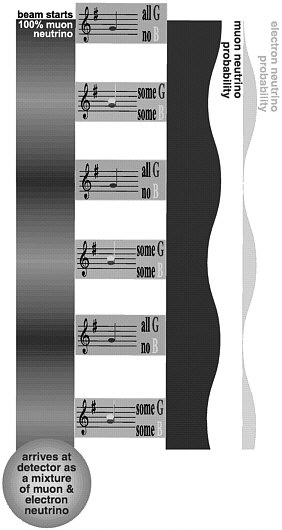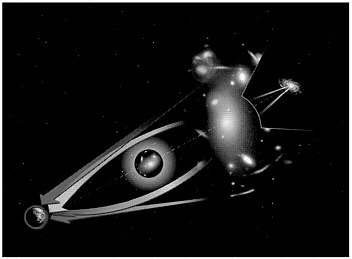2
Science Overview: Neutrinos and Beyond
Seventy-two years ago, Wolfgang Pauli, desperate to preserve the principle of energy conservation, postulated the idea of an unseen particle—the neutrino. Enrico Fermi gave the neutrino its name and wrote down the first description of how neutrinos interact with other particles. Because neutrinos are so light and without electric charge, they are almost inert (see Sidebar 2.1, “The Neutrino”). In spite of the fact that trillions of neutrinos go through each of us every second, it took nearly 30 years for Pauli’s hypothesis and Fermi’s theory to be confirmed. In 1956, Frederick Reines and his team detected neutrinos produced by a powerful nuclear reactor in Savannah River, South Carolina. He was awarded the Nobel Prize in physics for this discovery.
THE NEUTRINO: FROM BACKSTAGE TO CENTER STAGE
The neutrino is now central to elementary particle physics, astrophysics, and cosmology. Neutrinos play a key role in theories that unify the elementary particles and forces. They yield clues about the dark matter holding the universe together, and they are critical in understanding not only how the Sun shines but also how stars exploded to create the majority of the elements in the periodic table. Recent discoveries, however, have created special opportunities to use neutrinos in new ways to advance our knowledge of the universe and the laws that govern it.
Some 15 years after Reines established the existence of the neutrino, Raymond Davis, Jr., opened the neutrino window to the universe by using 100,000 gallons of
|
SIDEBAR 2.1 THE NEUTRINO Cosmic Gall Neutrinos, they are very small. They have no charge and have no mass And do not interact at all. The earth is just a silly ball To them, through which they simply pass, Like dustmaids down a drafty hall Or photons through a sheet of glass —John Updike1 The mysterious neutrino entered the popular culture in John Updike’s 1959 poem “Cosmic Gall.” He stated neutrinos’ two most important and puzzling features—masslessness and elusiveness. Today, we know that neutrinos are almost, but not quite, massless. The interaction between neutrinos and other forms of matter is extremely rare because they interact only through the weak nuclear force: It would take a wall of ordinary matter more than 100 light-years thick to stop a beam of neutrinos like those produced by the Sun. Precisely because they are so elusive, neutrinos produced at the center of the Sun traverse the entire mass of the Sun without being absorbed, allowing us to see deep into the Sun’s center (see Figure 4.4). There are three types of neutrinos: electron, mu, and tau neutrinos—so named because they are associated with the electron, muon, and tau particles. These six “leptons,” together with the six types of quarks—up, down, charm, strange, top, and bottom—are the basic building blocks of matter (see Figure 2.1.1). The three neutrinos differ from the nine other building blocks of matter because they are so light and interact so weakly. These two differences are at the root of their importance to modern astrophysics and physics. Said simply, the unique role of neutrinos is “seeing deep.” By detecting neutrinos from astrophysical objects we can see deep into the Sun, into exploding stars (supernovae), and someday, one can hope, into the mighty explosions that power the mysterious gamma-ray bursts seen across the universe. Neutrinos also allow us to study the forces of nature at the shortest distances by observing rare processes in which they participate. For instance, neutrinos permit us to “see deep” into the nuclei of atoms through the process of neutrino scattering from the quarks within the proton. Their tiny masses and the transformations of one neutrino type to another (see Figure 2.1.2) have even revealed physics beyond the Standard Model of particle physics. Studying and understanding neutrino mass and oscillation provide a unique view into how the forces and particles are unified. Because neutrinos are uncharged, it is possible that, like photons, they are their own antiparticles. If this is so, it may explain the existence of the kind of matter we are made of. Shortly after the big bang, there were equal amounts of matter and antimatter. Were it not for the fact that a slight excess of matter over antimatter developed later, all matter and antimatter would have been annihilated long ago. If neutrinos (of nonzero mass) are their own antiparticles (unlike quarks), additional pathways for matter-antimatter differences become possible, and thus neutrinos are likely to have played a role in how the slight excess of matter arose in today’s universe. |
cleaning fluid 4,000 feet below the surface in the Homestake Gold Mine to detect neutrinos produced by nuclear reactions occurring at the center of the Sun. These two experiments—one with reactor-produced neutrinos and the other with solar neutrinos—paved the way for the recent discoveries.
The advent of intense beams of neutrinos produced by particle accelerators quickened the pace of neutrino research—and discoveries. First came the discovery of a second type of neutrino by Leon Lederman, Melvin Schwartz, and Jack Steinberger in a pioneering neutrino experiment at Brookhaven National Laboratory, for which they received the Nobel Prize in physics in 1988. In the mid-1970s neutrino beams at the European Organization for Nuclear Research (CERN) in Europe and at Fermilab in the United States were used to discover a new force of nature (the neutral-current weak interaction). This discovery (and others) revealed that the electromagnetic and weak forces are just different aspects of a unified electroweak force and led to a Nobel Prize for American theorists Sheldon Glashow and Steven Weinberg and the late Pakistani theorist Abdus Salam.
Roughly 160,000 years ago a star 20 times the mass of our Sun exploded in the Large Magellanic Cloud. In February 1987, neutrinos produced by this explosion were detected by large underground water Cerenkov detectors in the United States (the Irvine-Michigan-Brookhaven (IMB) detector in the Morton Salt Mine in Ohio) and in Japan (the Kamiokande II detector in the Kamioka Mine). This discovery marked the beginning of extragalactic neutrino astronomy. It also confirmed astronomers’ basic picture of how massive stars explode and disperse the majority of the elements in the periodic table. Although supernovae are extremely bright—for a few days they produce as much visible light as the rest of the stars in their host galaxies—neutrinos carry away a thousand times more energy.
Both the IMB and Kamiokande II experiments also detected neutrinos produced by cosmic-ray interactions in Earth’s atmosphere and found a curious deficit of muon neutrinos relative to electron neutrinos. The continued study of this deficit by the larger and better instrumented Super-Kamiokande (Super-K) detector provided compelling evidence that neutrinos have mass. Super-K showed that the deficit was due to muon neutrinos oscillating (transforming) to another type of neutrino (probably tau neutrinos). Oscillation experiments can only measure the differences in squares of the masses between two neutrino types, and by determining this difference the Super-K experiment set a lower limit on the mass of the heaviest neutrino: one ten-millionth the mass of the electron.
Such a tiny mass may not seem very important, but in fact, the implications for elementary particle physics, astrophysics, and cosmology are very profound. The highly successful Standard Model of particle physics cannot accommodate neutrinos with mass, even with masses this tiny. Thus, the existence of neutrino mass is the first sign of the long-sought grander theory that would unify the forces
and particles of nature; the fact that neutrino masses are extremely small is an important clue about how the forces are unified.
Because the universe is awash with neutrinos left over from its big-bang beginning, even the smallest mass consistent with the Super-K experiment would mean that neutrinos contribute as much to the mass budget of the universe as do bright stars. Masses this small may also influence the dynamics of how massive stars explode to produce the chemical elements.
In 2001 and 2002, results from the Sudbury Neutrino Observatory (SNO) detector in the Inco Mine in Sudbury, Ontario, brought clarity to the long-standing solar-neutrino problem. Beginning with Davis’s discovery experiment, every solar-neutrino experiment has seen far fewer solar neutrinos than astrophysical theory predicts. The SNO experiment, with its ability to detect tau- and muon-type neutrinos, showed that although the predicted number of neutrinos arrive at Earth, some of the electron neutrinos produced by the Sun have been transformed into other types of neutrinos along the way. The SNO experiment also identified a second mass difference in the neutrino family. For the three known neutrino types, there are only two independent mass differences; however, the absolute scale of neutrino mass remains undetermined.
Two other recent discoveries—mysterious flashes of gamma rays, which occur about once a day, and photons from distant galaxies with a trillion times the energy of visible light—suggest that there are observable astrophysical sources of neutrinos in addition to the Sun and supernovae (see Sidebar 2.2, “Cosmic Rays and Cosmic Accelerators”).
Satellites monitoring Earth for nuclear explosions discovered sources of gamma-ray bursts serendipitously. Only in the last 5 years were their locations pinpointed to galaxies at the edge of the observable universe. These, the most energetic explosions known, which transform enormous energy into gamma rays over a few seconds, are thought to be associated with the collisions of neutron stars and black holes or with the violent collapse of massive stars. Large, Earth-based gamma-ray telescopes also discovered sources of constant emission of gamma rays with even higher energies in a handful of galaxies known to harbor supermassive black holes. The gamma rays we observe are likely to have been attenuated by material inside and outside the sources. Both gamma-ray bursts and the jets formed around supermassive black holes are thought to emit neutrinos as well.
If these new heavenly sources of neutrinos do exist, the neutrinos they emit have very high energies, more than a million times those produced by the Sun and supernovae. The ability of neutrinos to escape from deep inside objects across the universe opens a new window to study the most exotic astrophysical events and perhaps to learn more about the properties of neutrinos themselves.
|
SIDEBAR 2.2 COSMIC RAYS AND COSMIC ACCELARATORS Shortly after the discovery of radioactivity more than 100 years ago, physicists discovered that Earth is constantly bombarded by cosmic rays from space. Today, the cosmic rays are known to consist of protons, photons, nuclei of atoms from helium to uranium, electrons and positrons, neutrinos, and possibly particles yet to be identified, with energies ranging from millions of electron volts to more than a billion trillion electron volts. Cosmic rays colliding with Earth’s atmosphere produce tremendous numbers of muons and neutrinos.1 Our Sun and exploding stars within our galaxy and others all produce cosmic rays. Not only do the cosmic rays provide samples of material from throughout the universe, but they also give us access to particles with energies well beyond those that can be produced by earthly accelerators. However, cosmic rays and their debris can interfere with very sensitive experiments looking for rare events. To escape these cosmic-ray muons, physicists have taken their experiments deep underground to search for rare events. The existence of high-energy cosmic rays raises the question of how they originated and were accelerated. There are a variety of acceleration mechanisms, ranging from shock waves produced by exploding stars or by gamma-ray bursts to supermassive black holes with strong magnetic fields. Neutral particles like photons and neutrinos cannot be accelerated by electric fields, which are the primary means for accelerating electrons and protons to high energy. One explanation for the very high energy photons recently detected from supermassive black holes is that protons are accelerated to high energy and produce pi mesons when they encounter matter; the pi mesons ultimately decay and produce photons and neutrinos. There are also models for cosmic acceleration that do not include detectable neutrino emissions. Scientists are ready to turn to the universe to see which explanation is more correct. If the proton acceleration explanation is correct, then there should also be very high energy neutrinos coming from these and other supermassive black holes. |
BEYOND NEUTRINOS
Some 50 years after Pauli’s desperate proposal to save the principle of energy conservation, physicists and astronomers proposed another particle to save another important principle of physics—gravity. Fritz Zwicky, Vera Rubin, and other astronomers showed that galaxies and clusters of galaxies do not contain enough matter in the form of stars to be held together by gravity as we understand it (see Sidebar 2.3, “Shedding Light on Dark Matter”). This means either that our present understanding of gravity is incorrect or that there must be a nonluminous form of matter (now called dark matter) that holds these objects and the universe together.
The case has grown more interesting in the past decade: By establishing that the total amount of ordinary matter (matter made of neutrons, protons, and electrons) falls short by a factor of seven of being able to account for the needed dark matter, astrophysicists have now raised the stakes. A new form of matter must explain the dark matter. Like the neutrino before it, the hypothesized dark-matter
|
spread out, extending far beyond its visible edge. Astonishingly, stars account for only a small fraction of the galactic mass. The bulk of the mass of a galaxy exists in an extended, almost spherical distribution known as the dark halo. The defining feature of the halo is this darkness, and so the needed additional matter is referred to as dark matter. We know the dark matter must be there because without its gravity, the stars within galaxies (including our own) would not remain together. In recent years, evidence for dark matter has strengthened. Dark matter holds all structures larger than galaxies together and accounts for most of the matter in the universe. In clusters of galaxies, the effects of dark matter are so pronounced that it distorts the images of distant galaxies beyond the cluster by its gravitational bending of their light (see Figures 2.3.1 and 2.3.2). 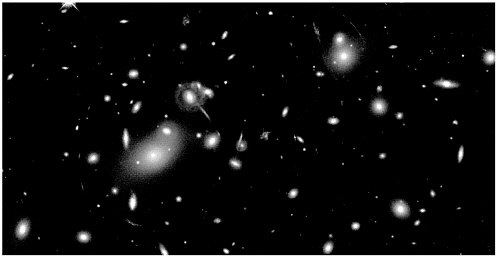 FIGURE 2.3.2 This Hubble Space Telescope image shows how the dark matter in the cluster of galaxies (seen as the yellow images) bends the light from more distant faint blue galaxies, creating multiple images of some galaxies and distorting the shapes of others. The use of gravitational lensing allows astronomers to map the dark matter in clusters of galaxies and to directly reveal the enormous amount of dark matter. Image courtesy of NASA, A.Fruchter, and the ERO team. |
particle must be neutral and must interact very weakly with ordinary matter, making it challenging to detect.
Could neutrinos be the cosmic dark matter? While we are now confident that they account for at least some part of it, upper limits to the masses of neutrinos from experiments involving the nuclear decay of tritium (a heavy form of hydrogen) already preclude the possibility that neutrinos constitute all of the dark matter.
There is now a strong case for the existence of a new particle, which, like the neutrino, must be uncharged and almost inert but may account for the bulk of the dark matter in the universe. This idea has resonated with particle theorists, whose unified theories predict the existence of new types of stable particles with just the properties needed for dark matter.
In addition to predicting a dark-matter particle and neutrino mass, unified theories make a third prediction—the instability of the matter of which we are made. Needless to say, the rate of the decay of protons must be exceedingly slow: Current experiments indicate that the average lifetime of the proton exceeds 1033 years, so that very few have decayed since the big bang. The prediction of matter instability is bolstered by evidence that the strengths of the strong and electroweak forces approach a common value at very high energies, an indication of the unification of the forces that sets a possible energy scale for the undiscovered forces responsible for proton decay. Some theoretical predictions of the lifetime of the proton are within the reach of a new generation of experiments; the absence of observed decays will also constrain theory.
The decay of the proton and dark-matter interactions with ordinary matter are extremely rare events—more challenging to detect than even neutrinos. Like neutrinos, however, they offer a new window on nature and the possibility of learning about the universe and about the deepest inner workings of the physical laws that govern it.
SPECIAL OPPORTUNITIES
The recent discoveries involving neutrinos, dark matter, and sources of very high energy photons have deepened our understanding of both the universe and the laws that govern it. In addition, these discoveries point to new opportunities for even greater advances. The questions that we are now poised to answer include these:
-
Why do neutrinos have tiny masses, and how do they transform into one another?
-
Are the existence and stability of ordinary matter related to neutrino properties?
-
Are there additional types of neutrinos?
-
What is the mysterious dark matter, and how much of it consists of neutrinos?
-
What causes the most powerful explosions in the universe?
-
What role do neutrinos play in the synthesis of the elements in the periodic table?
-
How do supermassive black holes produce very high energy gamma rays?
-
Is there a deeper simplicity underlying the forces and particles we see?
No single experiment can realize all of these opportunities. A concerted program of experiments is required. For instance, rare nuclear-decay experiments (such as double beta decay) have the potential to probe the absolute scale of neutrino mass down to the minimum mass indicated by the Super-K and SNO experiments, but only if the neutrino meets certain other conditions (that is, if it behaves as a Majorana particle). To observe and study these rare events requires laboratories shielded from the cosmic rays that bombard Earth (see Sidebar 2.2, “Cosmic Rays and Cosmic Accelerators”).
The technology has now been developed to detect a wide spectrum of weakly interacting dark-matter particles, candidates for the composition of the halo of our galaxy. The current experiments are ready to be scaled up and operated in laboratories well shielded from cosmic rays.
To sort out precisely how the different neutrino types transform into one another will likely require intense accelerator-produced neutrino beams aimed at large, faraway detectors. (A large distance is required for the neutrinos to oscillate; the intense beams and large detectors are needed to observe the rare neutrino interactions, which become more diffuse at large distances.) A new generation of solar-neutrino experiments focused on the lowest-energy solar neutrinos will likely also be needed.
Astronomers have learned much about the universe by observing the different kinds of electromagnetic radiation that exist in nature (see Figure 2.1). The different forms of light are distinguished by their wavelengths and energies and require different kinds of detectors. Visible light, familiar because it can be seen with our eyes, reveals the presence of stars similar to and at the same stage of (stellar) life as our Sun, but this light offers only a small window on the full spectrum. Infrared radiation is able to penetrate the clouds that obscure the birth of stars and planets. Microwaves reveal the birth of the universe in the form of the cosmic microwave background. X rays and gamma rays provide a window onto the most energetic
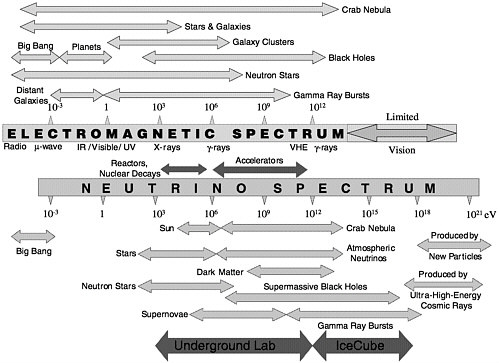
FIGURE 2.1 A comparison of the electromagnetic and neutrino windows on the universe, which is important because both IceCube and a deep underground lab will be sensitive to neutrinos. Astronomers view the universe with light of greatly different wavelengths and energies, from long-wavelength microwaves whose energies are 10,000 times less than that of visible light to very short wavelength gamma rays whose energies are a trillion times greater than that of visible light. By exploiting the full electromagnetic spectrum, astronomers have revealed a great variety of objects in the universe, from the microwave glow of the big bang, to infrared radiation from planets, to the gamma rays emitted by supermassive black holes. Neutrinos of vastly different energies should also be produced by objects in the universe, from relic neutrinos left over from the big bang to those produced by the interaction of the most energetic cosmic rays with the cosmic microwave background radiation. Photons with energies between 1013 eV and 1019 eV can reach us only from our local neighborhood. The cause of this “limited vision” (i.e., partial electromagnetic blindess) is the interaction of photons with the diffuse background of infrared and microwave photons. Because their interactions with other particles are so much weaker, neutrinos are not so affected, so IceCube could allow us to see into these processes for the first time. Detection of sources of astrophysical neutrinos will give us new windows on the universe.
events in the universe, from matter falling into a black hole to nature’s most powerful accelerators.
Because they interact with matter so rarely, neutrinos have the potential to probe even deeper than the highest-energy gamma rays. Already the neutrinos detected from our Sun have shown us the nuclear fires burning at its center, and the neutrinos from Supernova 1987A have revealed the second-by-second progress of a supernova explosion. The potential of neutrinos as new “eyes” on the universe is far from being fully realized. Because very high energy neutrinos are more interacting than low-energy neutrinos (i.e., they have a larger cross section), the chance of observing them in a terrestrial detector is greater. Thus, it is more likely that with “eyes” sensitive to very high energy neutrinos, researchers will see astrophysical sources. Even so, enormous detectors (at least a kilometer on a side) are required. The sources visible to such a detector include supermassive black holes, the mysterious gamma-ray bursters, and the high-energy neutrinos produced by the annihilation of dark-matter particles that are captured by our Sun.
While detecting very high energy cosmic neutrinos requires the largest-volume detectors yet proposed by scientists, a host of additional frontier experiments require laboratory space of a different nature. Double beta decay experiments, solar-neutrino projects, detectors to observe accelerator-produced neutrinos at great distances, experiments to detect the dark matter that holds together our own galaxy, and searches for proton decay all require laboratory space that is well shielded from the cosmic rays that bombard Earth. These projects address complementary sets of questions and require a dedicated environment to research and develop the answers.

